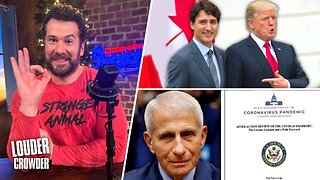Premium Only Content

Are Key Market Indicators Signaling Something Big? - Andy Tanner
Host Andy Tanner is joined by financial experts Noah Davidson and Corey Halliday to break down recent market movements and discuss key strategies for navigating the constantly shifting financial landscape. Whether you’re a seasoned investor or just starting out, this episode offers valuable insights into risk management, market indicators, and the importance of preparedness in investing.
Recent Market Movements: A Blip or a Sign?
The episode kicks off with a discussion about the recent market dive, which sparked concerns among investors. While some feared a significant downturn, the consensus among the experts was that this was not a systemic issue but rather a temporary blip caused by a significant institutional squeeze leading to heavy liquidations. Corey Halliday noted that despite the spike in the VIX (Volatility Index), which measures market volatility, the situation was more of an anomaly than a reflection of a looming crisis.
Understanding the VIX and Market Sentiment
The VIX, often referred to as the "fear gauge," is crucial for investors to understand. It measures the market's expectation of volatility and spikes when there’s high demand for options to hedge against risk. While the recent VIX spike suggested fear levels comparable to past financial crises, Corey explained that this was more of a bad tick than an accurate reflection of market conditions.
Advanced Risk Management: The ARMOR Strategy
In response to market volatility, having a solid risk management strategy is essential. The ARMOR strategy—Advanced Risk Management and Opportunity Readiness—was introduced as a way to help investors prepare for downturns and capitalize on market pullbacks. Corey shared an example of how buying VIX options when the index was low turned out to be highly profitable during the recent volatility spike, illustrating the importance of being prepared.
Key Market Indicators: Consumer Discretionary Spending and Sector Rotation
Noah Davidson highlighted the significance of monitoring consumer discretionary spending as an indicator of economic health. A shift from discretionary stocks to staples and defensive sectors often signals that institutions are playing defensively, anticipating potential economic downturns. This sector rotation is a proactive strategy used by institutions to brace for market shifts.
Preparing for Bigger Economic Moves
While the market remains stable for now, Corey suggested that we might not be far from an economic situation that could see larger dominoes falling. Potential rises in unemployment and other economic stressors could create a more challenging environment in the near future.
Housing Starts and Their Economic Impact
Andy Tanner pointed out the importance of housing starts as a key economic indicator. With high-interest rates cooling the housing market, fewer people are selling their homes to buy new ones, which could signal broader economic challenges.
Education and Readiness: Key to Successful Investing
The episode concludes with a strong emphasis on the importance of education and readiness in investing. Andy stressed that being mentally and tactically prepared is just as crucial as having the financial means. Advanced strategies like Delta hedging or using futures to manage risk can make a significant difference in navigating market complexities.
FREE Training with Andy Tanner: https://bit.ly/3U3HAPY
00:00 Introduction and Market Overview
04:26 Market Volatility and the VIX
06:31 Insurance and Risk Management Strategies
09:38 Special Class: ARMOR
13:22 Trading Strategies and Historical Context
24:31 Currency Risks and Carry Trades
30:43 Economic Stability and Future Concerns
32:01 Consumer Discretionary as an Economic Indicator
34:09 Sector Rotation and Defensive Moves
35:33 Warren Buffett's Investment Strategies
39:00 Labor Market and Economic Trends
40:53 Credit Card Debt and Economic Tipping Point
47:02 Preparing for Market Opportunities
51:12 Understanding VIX and Market Volatility
55:59 Closing Thoughts and Final Remarks-----
Disclaimer: The information provided in this video is for educational and informational purposes only. It should not be considered as financial advice or a recommendation to buy or sell any financial instrument or engage in any financial activity.
The content presented here is based on the speaker's personal opinions and research, which may not always be accurate or up-to-date. Financial markets and investments carry inherent risks, and individuals should conduct their own research and seek professional advice before making any financial decisions.
-
 26:36
26:36
The Rich Dad Channel
5 days agoTrump’s Plan to Overturn Biden’s Climate Policies - Mike Mauceli, Paul Tice
3.81K -
 LIVE
LIVE
vivafrei
2 hours agoRay Epps Fed-Surrection Cover-Up? Hunter Biden Pardon Fallout! Plan-Demic Failures & MORE!
3,286 watching -
 LIVE
LIVE
MDGgamin
3 hours ago🔴LIVE- Wake Up Stream Repeat - Games & Chatting - #RumbleTakeover
168 watching -
 1:38:13
1:38:13
Mostly Sports With Mark Titus and Brandon Walker
22 hours agoThe World Needs More Jameis Winston & Bo Nix | Mostly Sports EP 302 | 12.3.24
15.2K2 -
 DVR
DVR
TheAlecLaceShow
4 hours agoDoes Racism Exist? Guest: Franck Zanu | Elon’s Viral Meme | Hunter Pardon | The Alec Lace Show
5.07K2 -
 LIVE
LIVE
G2G Gaming Channel
6 hours agoI heard Smite, So Im here! #RumbleTakeOver #RumbleGaming
125 watching -
 15:36
15:36
Neil McCoy-Ward
2 hours ago🚨 Emergency Martial Law Declared, Special Forces Deployed...
12.7K5 -
 1:57:30
1:57:30
The Charlie Kirk Show
2 hours agoDemocrat Billionaires in Crisis + Fixing the Migrant Crisis | Blagojevich, O'Brien, Metaxas| 12.3.24
51.5K9 -
 1:01:07
1:01:07
The Dan Bongino Show
5 hours agoBiden’s Reign Of Destruction Isn’t Over Yet (Ep. 2381) - 12/03/2024
611K1.51K -
 1:59:02
1:59:02
Steven Crowder
5 hours ago🔴 COVID Chronicles: The Hidden Truths of the Pandemic Exposed
336K201